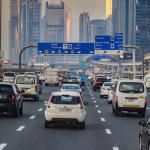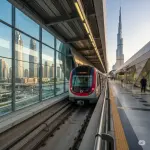The United Arab Emirates, with its modern cities and sprawling infrastructure, offers a comprehensive and increasingly efficient public transportation system. For tourists looking to explore the iconic landmarks without the hassle of driving, and for new residents seeking cost-effective ways to commute, understanding the options available is key. From the sleek Dubai Metro to the extensive bus networks and readily available taxis across the Emirates, navigating the UAE without a personal vehicle is not only feasible but can also be a convenient and budget-friendly way to experience the country.
This detailed guide will walk you through the primary modes of public transportation in the UAE, providing essential information on how to use them effectively, understand their costs, and make the most of your travel within the Emirates.
1. The Dubai Metro: Efficiency and Connectivity
The Dubai Metro stands as a symbol of the city's modernity and offers a rapid, efficient, and air-conditioned way to travel through major urban areas. It’s particularly useful for reaching key attractions and business districts.
- Lines and Coverage: The Dubai Metro currently comprises two main lines: the Red Line, which runs parallel to Sheikh Zayed Road, connecting Rashidiya in the east to Jebel Ali in the west, and the Green Line, which runs through older parts of the city, connecting Etisalat in the north to Creek in the south. Expansion plans are frequently underway to further extend the network.
- Operating Hours: The Metro generally operates from early morning (around 5:00 AM or 5:30 AM) until midnight, with slightly different timings on Fridays and public holidays. It’s always best to check the official RTA (Roads and Transport Authority) Dubai website or app for the most up-to-date schedules.
- NOL Card: Your Ticket to Ride: To use the Dubai Metro, you’ll need a NOL card, a contactless smart card that can be topped up and used across various RTA transport modes, including buses, trams, and water buses. NOL cards come in different types (Red Ticket, Silver, Gold, Blue), offering varying benefits and validity periods. For regular use, a Silver or Gold NOL card is recommended.
- How to Use: Simply tap your NOL card on the reader at the entry and exit gates of the Metro stations. The fare is automatically deducted based on the number of zones you’ve traveled through. Be sure to have sufficient balance on your card before starting your journey.
- Benefits:
- Speed and Efficiency: Avoids traffic congestion, offering a quick way to travel long distances within Dubai.
- Cost-Effective: Generally more affordable than taxis for longer distances.
- Environmentally Friendly: A greener mode of transport.
- Accessibility: Most stations are equipped with elevators and escalators, making them accessible for people with reduced mobility.
- Considerations:
- Can get crowded during peak hours.
- Coverage is primarily within Dubai; it doesn't extend to all areas of the city or other emirates.
- You may need to use feeder buses or taxis to reach your final destination from a Metro station.
2. The Extensive Bus Networks: Reaching Every Corner
The UAE boasts well-maintained and extensive bus networks that complement the Metro and reach areas not directly served by the rail system. Each emirate typically has its own bus service provider (e.g., RTA Buses in Dubai, Abu Dhabi Link and Buses in Abu Dhabi).
- Coverage and Routes: Bus routes are widespread, connecting residential areas, commercial hubs, and tourist attractions. While Dubai has a particularly comprehensive network, other emirates also have reliable bus services. It’s advisable to use online journey planners or dedicated transport apps to find the best routes and timings.
- Operating Hours: Bus services generally operate throughout the day, with varying frequencies depending on the route and time of day. Some routes may have limited or no service during late-night hours.
- Payment Methods: In Dubai, NOL cards are also used for bus fares. Simply tap your card on the reader when boarding and alighting. In other emirates, payment methods might vary, including NOL-like cards or cash payments. It's always best to have the correct fare or a valid travel card.
- Benefits:
- Wide Coverage: Buses reach a broader range of locations compared to the Metro.
- Affordable: Bus fares are generally the most economical option for public transport.
- Air-Conditioned: Most buses in the UAE are air-conditioned, providing relief from the heat.
- Considerations:
- Can be slower than the Metro, especially during peak traffic hours.
- Route information and schedules may require some initial research, particularly when traveling in less familiar areas or other emirates.
3. Taxis: Convenience at Your Doorstep
Taxis are readily available throughout the UAE and offer a convenient, albeit often more expensive, mode of transport. They are particularly useful for short distances, reaching destinations not easily accessible by Metro or bus, or when traveling with luggage.
- Availability: Taxis can be hailed on the street (in designated areas), booked through phone dispatch services, or via ride-hailing apps like Careem and Uber (which are widely used in the UAE). Airport and major tourist spots usually have dedicated taxi stands.
- Regulation and Safety: Taxi services in the UAE are generally regulated, and vehicles are metered. It’s advisable to ensure the meter is running at the start of your journey. For safety, especially for solo female travelers, booking through reputable apps or official taxi services is often recommended.
- Fares: Taxi fares vary between emirates and typically include a flag-down rate plus a charge per kilometer. Waiting times can also incur additional charges. Ride-hailing apps may have dynamic pricing based on demand.
- Payment Methods: Most taxis accept cash payments in UAE Dirhams. Increasingly, many taxis also accept card payments, but it’s always wise to confirm with the driver before starting your journey. Ride-hailing apps usually handle payments through the app.
- Benefits:
- Convenience: Door-to-door service, available almost anywhere and anytime.
- Direct Routes: Can take the most direct route to your destination.
- Comfort: Provides a private and comfortable mode of transport.
- Considerations:
- Can be significantly more expensive than the Metro or bus, especially during peak hours or for longer distances.
- Subject to traffic congestion, which can increase travel time and cost.
4. Intercity Travel: Moving Between Emirates
For traveling between the different emirates, several options are available:
- Intercity Buses: Each emirate has bus services that connect to other major cities. For example, RTA Dubai operates intercity buses to Abu Dhabi, Sharjah, Ajman, and other emirates. These are a cost-effective way to travel between cities. Timetables and routes can usually be found on the respective transport authority websites.
- Taxis: Intercity taxi services are available but can be quite expensive. It’s often advisable to negotiate the fare beforehand or agree on a metered journey.
- Ride-Hailing Apps: Apps like Careem and Uber can sometimes be used for intercity travel, but fares can be higher than standard taxis.
Tips for Navigating Public Transportation in the UAE:
- Plan Your Journey: Use online journey planners (like Google Maps or the RTA Dubai app’s S’hail) to find the best routes and estimated travel times.
- Download Transport Apps: Apps from RTA Dubai, Abu Dhabi Link, and ride-hailing services can provide real-time information, bus timings, and booking options.
- Purchase a Travel Card: If you plan to use public transport frequently, a NOL card (in Dubai) or a similar card in other emirates can save you time and potentially money.
- Be Mindful of Peak Hours: Public transport can get crowded during rush hours (typically Sunday to Thursday mornings and afternoons).
- Respect Local Customs: Be mindful of local customs and etiquette when using public transport.
- Stay Hydrated: Especially during the hotter months, carry water with you when using public transport, as waiting times can sometimes be longer than expected.
- Check for Updates: Transport schedules and routes can sometimes change, so it’s always a good idea to check the latest information from official sources.
Conclusion:
The UAE’s public transportation system offers a viable and increasingly attractive alternative to private vehicles. By understanding the nuances of the Dubai Metro, the extensive bus networks across the Emirates, and the convenience of taxis, both tourists and new residents can navigate the country with ease and affordability. As the UAE continues to invest in and expand its public transport infrastructure, exploring the Emirates without a car is becoming an ever more seamless and enjoyable experience. Embrace the opportunity to discover the UAE from a different perspective, riding the Metro, hopping on a bus, or taking a taxi to uncover the diverse offerings of this fascinating nation










